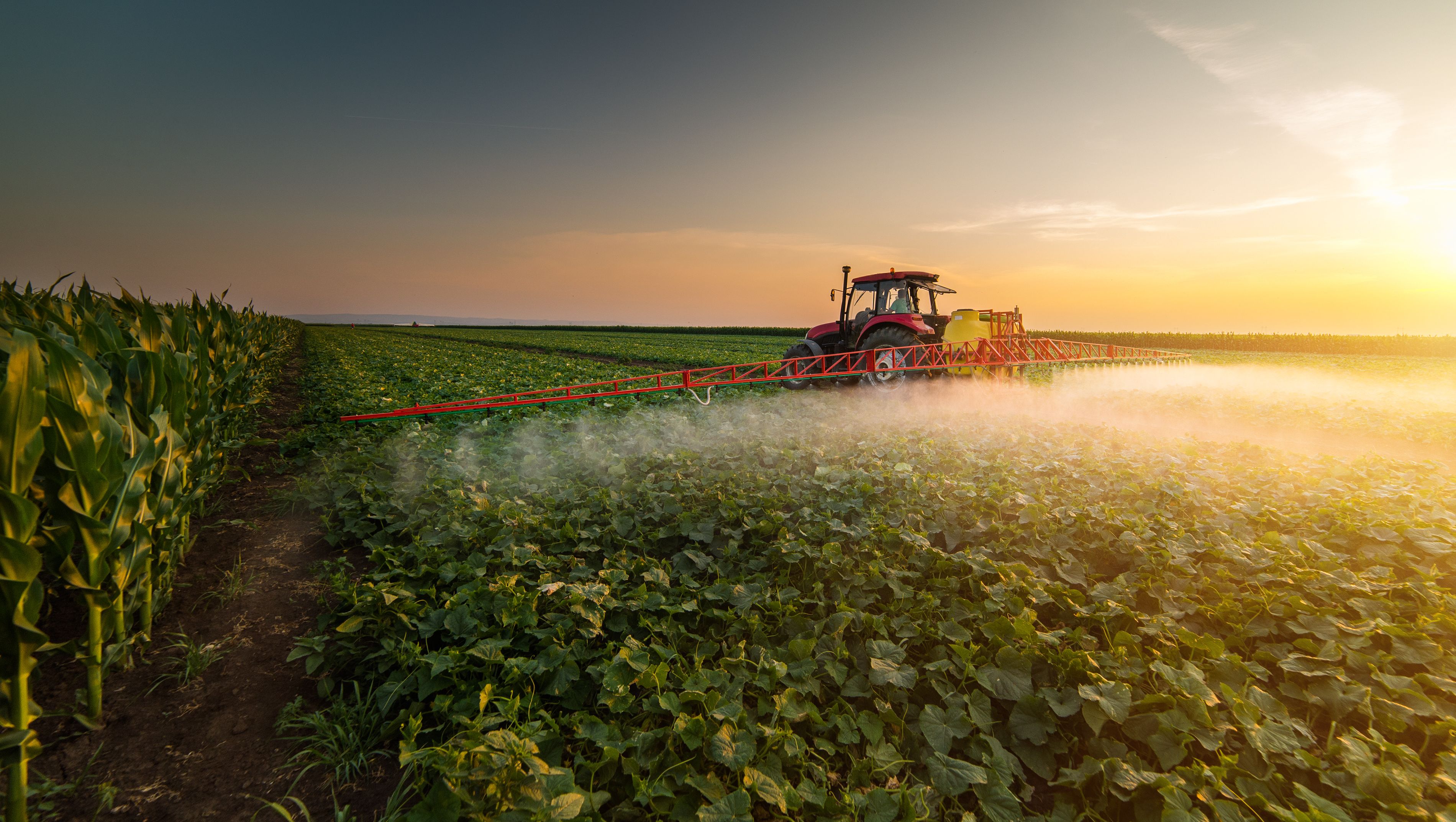Young Scientist Awardee Uses Spectrophotometry and AI for Pesticide Detection Tool
Sirish Subash is the winner of the Young Scientist Award, presented by 3M and Discovery education. His work incorporates spectrophotometry, a nondestructive method that measures the light of various wavelengths that is reflected off fruits and vegetables.
On October 16th, 2024, 3M and Discovery Education announced in a press release that ninth grader Sirish Subash as the winner of the 3M Young Scientist Challenge (1). Subash, a student at Gwinnett School of Mathematics, Science, and Technology in Georgia, developed a project called Pestiscand, which is a handheld device that could detect pesticide residues on produce using spectrophotometry (1).
Tractor spraying pesticides on vegetable field with sprayer at spring | Image Credit: © Dusan Kostic - stock.adobe.com

"Discovery Education is incredibly proud to support student innovation over the past 17 years through the 3M Young Scientist Challenge," said Amy Nakamoto, Executive Vice President of Corporate Partnerships at Discovery Education, in a press release announcing the finalists and winner (1). "It is more important than ever that future generations are given the tools needed to tackle real-world problems. Each remarkable participant has embodied the curiosity that will fuel these discoveries, and we congratulate them all."
Pesticide detection is of paramount importance in the agriculture industry. Because of threats from pests, many agricultural crops are treated with pesticides during the growing season (2). Once harvested, most of these crops still contain traces of pesticide residues on their products.
As a result, in an effort to safeguard human health, analytical techniques are needed to detect pesticide residues on crops. Surface-enhanced Raman spectroscopy (SERS), in particular, has been used as a tool for this purpose because of its sensitivity, specificity, and rapid analysis capabilities (2–4). By amplifying Raman signals through nanostructured metallic substrates, SERS enables the detection of pesticide residues at trace levels, often in the range of parts per billion (ppb) or lower (2–4).
Subash’s project employs spectrophotometry, a nondestructive method that measures the light of various wavelengths that is reflected off fruits and vegetables (1). Pestiscand also uses machine learning (ML) to analyze the spectral data, which helps determine the presence of pesticides and to what extent (1). Subash’s device contains multiple components, which include a sensor, power supply, display screen, and a processor. When his device was tested, it achieved an accuracy rate greater than 85% when detecting pesticide residues on tomatoes and spinach (1). As part of the challenge, Subash and the other finalists teamed up with a 3M scientist, who serves as a guide and collaborator to help the finalists take their innovations from concept to prototype (1). Subash was paired with Aditya Banerji, who currently serves as a Senior Research Engineer at 3M (1).
Subash becomes the 17th winner of the 3M Young Scientist Challenge. Minula Weerasekera from Beaverton, Oregon, and William Tan from Scarsdale, New York, took home second and third place, respectively, and their prizes included $2,000 (1). The fourth through tenth place winners include Ankan Das from Sanford, Florida; Steven Goodman from Lake Mary, Florida; Aakash Manaswi from Orlando, Florida; Prince Nallamothula from Frisco, Texas; Ronita Shukla from Acton, Massachusetts; Rithvik Suren from Ellington, Connecticut; and Hanna Suzuki from Bedford, Massachusetts (1).
Torie Clarke, the EVP and Chief Public Affairs Officer at 3M, said in a press release that the 10 finalists presented solutions to some of the most pressing challenges today.
"This year's Young Scientist Challenge finalists have demonstrated an incredible ability to develop creative solutions to some of the world's most pressing challenges," said Torie Clarke, EVP & chief public affairs officer at 3M (1). "I am beyond impressed and inspired by their intelligence and their scientific minds. Congratulations to this year's Top Young Scientist, Sirish Subash, and all the finalists for their phenomenal work."
References
- 3M, 14-year-old Named America's Top Young Scientist for Inventing an AI Handheld Pesticide Detector. 3M.com. Available at: https://news.3m.com/2024-10-16-14-year-old-named-Americas-Top-Young-Scientist-for-inventing-an-AI-handheld-pesticide-detector (accessed 2024-11-08).
- Wetzel, W. New SERS Imaging Technique Unveils Ultra-Sensitive Detection of Pesticide Residues in Crops. Spectroscopy. Available at: https://www.spectroscopyonline.com/view/new-sers-imaging-technique-unveils-ultra-sensitive-detection-of-pesticide-residues-in-crops (accessed 2024-11-08).
- Wetzel, W. New Method for Rapid SERS Detection of Pesticides in Agricultural Products Unveiled. Spectroscopy. Available at: https://www.spectroscopyonline.com/view/new-method-for-rapid-sers-detection-of-pesticides-in-agricultural-products-unveiled (accessed 2024-11-08).
- Wetzel, W. Revolutionary SERS Imaging Technique Enhances Pesticide Detection in Crops. Spectroscopy. Available at: https://www.spectroscopyonline.com/view/revolutionary-sers-imaging-technique-enhances-pesticide-detection-in-crops (accessed 2024-11-08).
AI and Dual-Sensor Spectroscopy Supercharge Antibiotic Fermentation
June 30th 2025Researchers from Chinese universities have developed an AI-powered platform that combines near-infrared (NIR) and Raman spectroscopy for real-time monitoring and control of antibiotic production, boosting efficiency by over 30%.
Toward a Generalizable Model of Diffuse Reflectance in Particulate Systems
June 30th 2025This tutorial examines the modeling of diffuse reflectance (DR) in complex particulate samples, such as powders and granular solids. Traditional theoretical frameworks like empirical absorbance, Kubelka-Munk, radiative transfer theory (RTT), and the Hapke model are presented in standard and matrix notation where applicable. Their advantages and limitations are highlighted, particularly for heterogeneous particle size distributions and real-world variations in the optical properties of particulate samples. Hybrid and emerging computational strategies, including Monte Carlo methods, full-wave numerical solvers, and machine learning (ML) models, are evaluated for their potential to produce more generalizable prediction models.
Combining AI and NIR Spectroscopy to Predict Resistant Starch (RS) Content in Rice
June 24th 2025A new study published in the journal Food Chemistry by lead authors Qian Zhao and Jun Huang from Zhejiang University of Science and Technology unveil a new data-driven framework for predicting resistant starch content in rice
New Spectroscopy Methods Target Counterfeit Oral Medication Syrups
June 23rd 2025Researchers at Georgia College and Purdue University have developed a fast, low-cost method using Raman and UV–visible spectroscopy combined with chemometric modeling to accurately screen and quantify active ingredients in over-the-counter oral syrups, helping to fight counterfeit medications.